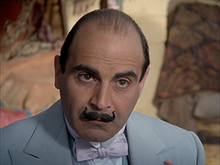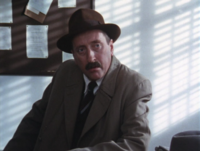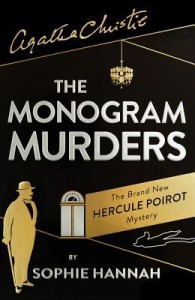 Format read: ebook borrowed from the library
Format read: ebook borrowed from the libraryFormats available: hardcover, paperback, ebook, audiobook
Genre: mystery
Series: Hercule Poirot #43, New Hercule Poirot #1
Length: 320 pages
Publisher: William Morrow
Date Released: September 9, 2014
Purchasing Info: Sophie Hannah’s Website, Agatha Christie’s Website, Publisher’s Website, Goodreads, Amazon, Barnes & Noble, Kobo, Book Depository
Hercule Poirot’s quiet supper in a London coffeehouse is interrupted when a young woman confides to him that she is about to be murdered. She is terrified – but begs Poirot not to find and punish her killer. Once she is dead, she insists, justice will have been done.
Later that night, Poirot learns that three guests at a fashionable London Hotel have been murdered, and a cufflink has been placed in each one’s mouth. Could there be a connection with the frightened woman? While Poirot struggles to put together the bizarre pieces of the puzzle, the murderer prepares another hotel bedroom for a fourth victim…
My Review:
I enjoyed reading The Monogram Murders quite a bit. Enough to finish it in a single day.
However, for all the purists out there, my primary introduction to the works of Dame Agatha is through the TV series; I have read a very few of the actual books, but mostly, I have enjoyed the various performances of her work.

I could hear David Suchet as Poirot in many of his lines in The Monogram Murders. Which does not make the book the epitome of Dame Agatha’s, work, but does make it seem in keeping with his TV portrayal of Poirot. So perhaps a good adaptation of an adaptation?
The entree to The Monogram Murders certainly seemed to fit Poirot; he takes a vacation to rest his “little grey cells” by pretending to leave London. Instead he takes a room at a boarding house within sight of his apartments.
He also finds a mystery where at first there doesn’t seem to be one; the mysterious and seemingly frightened “Jennie” who interrupts his dinner to announce that someone is trying to murder her and that she deserves it. The scenario is guaranteed to garner Poirot’s interest. As it was intended both by the author and by Jennie herself.
All of Poirot’s mysteries are complicated and convoluted, and this one proves to be no exception.
Meanwhile, Poirot’s erstwhile friend, the police detective Edward Catchpool, has left the scene of not one, but three murders in an upscale hotel. Although the victims initially seem to have nothing in common, all their bodies were formally laid out in the same ceremonial manner, leading to the inevitable conclusion that they were all murdered by the same person.
When Poirot and Catchpool relate their evening activities to each other back at the rooming house, Poirot immediately jumps to the conclusion that his mysterious Jennie is somehow involved with Catchpool’s three murders.
Catchpool is a reasonably good detective; his version of Occam’s Razor tells him that while the three murder victims must have something to do with each other, Poirot’s Jennie, while possibly in trouble, couldn’t possibly have anything to do with his case.
Of course Catchpool is wrong, or this wouldn’t be a case for Hercule Poirot.

Poirot takes it upon himself (doesn’t he always?) to insert himself into his friend’s case. Catchpool is savvy enough to know that while he will get the official credit (or official blame if it goes wrong) it is really Poirot’s case and Catchpool is just there to give Poirot official standing. He’s also aware that he isn’t senior enough to be left a case this big on his own without Poirot. He feels slightly trapped a good chunk of the time. (I wonder how Inspector Japp used to feel?)
The murders seem like the kind of overdone melodrama that is also designed to get Poirot’s attention. The three victims not only knew each other, but were involved in a long-ago scandal that resulted in two suicides. It’s no wonder that someone killed them, it’s just a question of who.
And whether or not there will be another victim before Poirot figures things out.
Escape Rating B-: As I said at the top, I could practically hear David Suchet reading Poirot’s dialog, so the story felt like it captured his “voice” pretty well.
On the other hand, and while this seems off-topic it wasn’t for me; Edward Catchpool’s name reminded me all too much of Eric Catchpole, the assistant on Lovejoy. Eric is not the brightest bulb in the pack, so that resemblance was not a good thing. (I digress)
I did wonder why the author created an entirely new sidekick for Poirot instead of using any of the familiar faces. Where was Japp? Has he retired by the time of this story? (I miss the original crew of Japp, Hastings and Lemon.)
One of the things that struck me in the book, that is often swept along by the action in the TV series, is just how convoluted the mystery turns out to be. Naturally, the perpetrator is never the obvious person, or Poirot’s help would not be needed, but still, the way that this particular crime reached back into the distant past felt a bit contrived.
Also, the originating scandal was one that may have been reasonable at the point where Christie was writing, but the behavior of the people in that small village 16 years previous to this story just didn’t feel true-to-life. Or it may be that times have changed just too much. Your mileage may vary.
 Although speaking of the times changing, the international cover of The Monogram Murders captures the art deco feeling that one associates with Poirot much better than the US cover. Again, mileage definitely varies.
Although speaking of the times changing, the international cover of The Monogram Murders captures the art deco feeling that one associates with Poirot much better than the US cover. Again, mileage definitely varies.
None of these quibbles change the fact that I had an absolutely marvelous time reading The Monogram Murders. It reminds me more than a bit of Jill Paton Walsh’s re-creations of Lord Peter Wimsey; it may not be the original, but it is the best we’ve got. If it’s an echo of Christie’s genius, it is still a lovely echo to hear.
